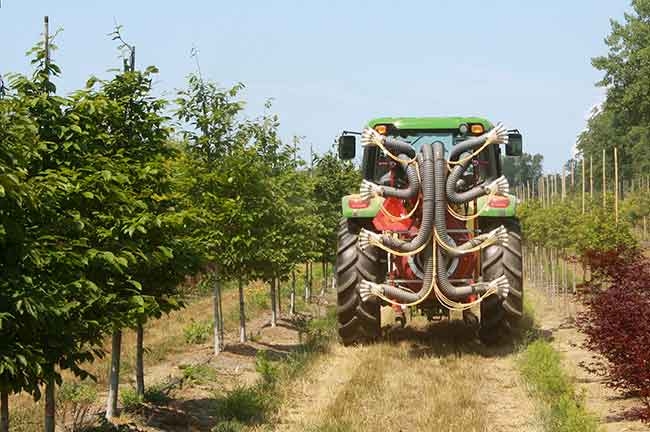
Equipment
Spraying
High-tech spraying
March 22, 2016 By Sharon Durham
 ARS’s new automated spraying system can detect the presence, size, shape, and foliage density of trees and then apply the optimum amount of pesticide in real time. Photo by Heping Zhu
ARS’s new automated spraying system can detect the presence, size, shape, and foliage density of trees and then apply the optimum amount of pesticide in real time. Photo by Heping Zhu
When applying chemicals to crops, where the chemical is delivered is sometimes more important than how much is delivered.
A team of U.S. Department of Agriculture Agricultural Research Service (ARS) scientists has developed a new laser-guided spraying system that controls spray outputs to match targeted tree structures.
“Conventional spray application technology requires excessive amounts of pesticide to achieve effective pest control,” says ARS agricultural engineer Heping Zhu. “This challenge is now overcome by our automated, variable-rate, air-assisted, precision sprayer. The new system is able to characterize the presence, size, shape, and foliage density of target trees and apply the optimum amount of pesticide in real time.”
The system has many parts that have to work together with precision, including a high-speed laser-scanning sensor working in conjunction with a Doppler radar travel-speed sensor.
“Our field experiments showed that the precision sprayer, when compared to conventional sprayers with best pest management practices, consistently sprayed the correct amount of chemicals, despite changes in tree structure and species,” Zhu says.
“Pest control with the new sprayer was comparable to that of conventional sprayers, but the new sprayer reduced average pesticide use between 46 and 68 per cent, with an average pesticide cost savings of $230 per acre for ornamental nurseries. The cost savings can be much higher for orchards and other fruit crop productions.”
Additional tests in an apple orchard demonstrated that the new sprayer reduced spray loss beyond tree canopies between 40 and 87 per cent, airborne spray drift by up to 87 per cent, and spray loss on the ground between 68 and 93 per cent.
Sharon Durham is with Agricultural Research Service’s information staff.
Print this page